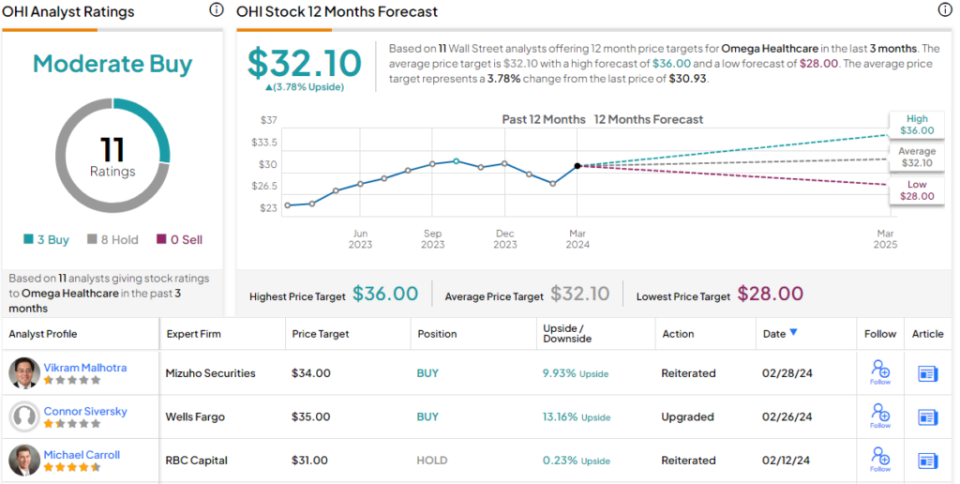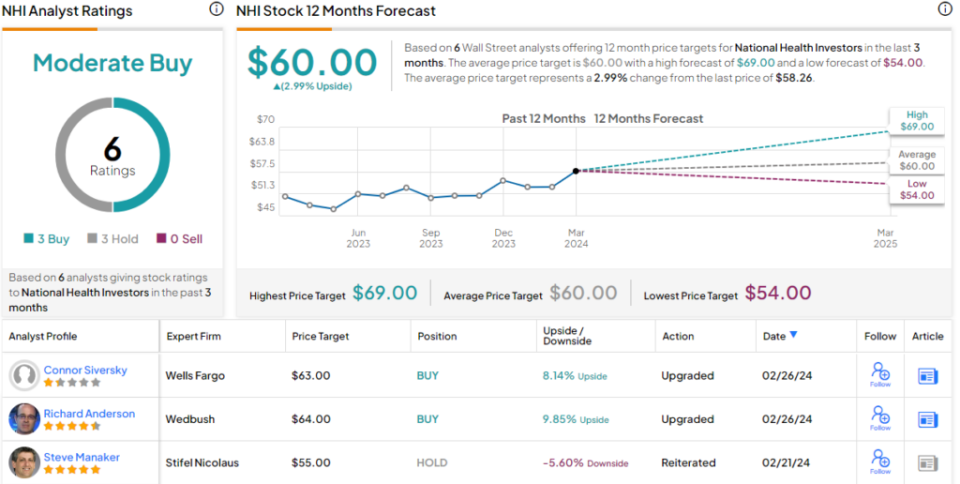Seeking up to 8.5% Dividend Yield? Well Fargo Suggests 2 Dividend Stocks to Buy
More than two months in to 2024, and markets are posting solid gains year-to-date, with the S&P 500 up by 7%, and the NASDAQ up just over 8.5%. These are good returns, but returns can always run higher – and one way to ensure that is to buy into high-yield dividend stocks. The best dividend payers offer a combination of reliability and high yield, that give investors a steady income well above the prevailing rates of inflation.
Div payers come in lots of flavors, and some offer more attractive sets of attributes than others. One less-common place to look for solid dividends is in skilled nursing facilities (SNFs). These medical facilities are designed for long-term care with patients who require close monitoring; think nursing homes and long-term rehabilitation hospitals.
And the link to dividends? A number of real estate investment trusts (REITs) focus their business activities on SNFs. These companies are benefiting from the aging demographics in the US. As the Baby Boomers and Gen Xers grow older, the over-65 population will increase from ~16% now to 22% or higher by 2050.
Wells Fargo analyst Connor Siversky is following this line of thought, seeing SNF-focused REITs as a solid play. He writes, “We are more positive on REIT SNF portfolios as operating metrics continue to improve. In our view, higher rent coverage should justify multiple valuations that are closer to, albeit still behind Pre-COVID levels.”
Getting into specifics, Siversky is suggesting 2 dividend stocks to buy, that offer investors up to 8% yields. With help from the TipRanks databanks, let’s take a closer look at them, to see just where they’re likely to go from here.
Omega Healthcare Investors (OHI)
The first stock we’ll look at is Omega Healthcare. This REIT got its start in 1992, and since then has built a remunerative portfolio based on SNFs, as well as assisted living facilities (ALFs) and memory care and behavioral care facilities. Omega operates as the owner of its portfolio properties, with the facility operations and management handled by the outside firms that hold the leases. The outside parties receive careful vetting, and Omega leases its properties mainly on the long-term triple-net lease model. In addition, Omega will provide financing on some of its properties, for fixed-rate mortgage loans.
Omega has prioritized stability in its portfolio. The company sets its typical lease agreement for 10 years, and makes extensions available to the leaseholders. This is conducive to creating a steady income stream from the portfolio. And – Omega’s portfolio is extensive. The company works in 42 US states and the UK, and bases its business on 862 properties. These properties boast a total of 84,125 beds, and are operated by 69 leaseholder firms.
Getting down to the brass tacks, we find that Omega’s business generated $239.3 million in total revenue in the last reported quarter, 4Q23. This was up a robust 65% year-over-year and beat the forecast by $32.7 million. Omega realized an adjusted FFO, or funds from operations, of $173 million – 68 cents per share, a figure that was a penny better than had been expected. FFO is a key metric in the REIT industry, as it covers the dividend.
On the dividend, Omega last paid out on February 15. The payment went out at 67 cents per common share, fully covered by the adjusted FFO. The annualized rate of $2.68 per common share gives a yield of more than 8.5%, enough to ensure a real rate of return.
When we check in with Wells Fargo’s Siversky, we see the analyst bullish on the stock, noting that Omega can afford its dividend and has solid prospects to increase the funds from operations. He writes of the company, “Importantly, 2024 guidance suggests that the dividend will be covered in the back half of the year. Rent coverage improvements should be reinforced by the impact of rate increases that should reflect in 1Q24 numbers, and should justify a higher AFFO multiple vs. current levels. Maplewood remains a concern in our view, but is balanced by forthcoming resolutions related to Guardian and LaVie.”
Siversky goes on to quantify his stance with an Overweight (Buy) rating, and he sets a price target of $35, implying an upside of 13% for the next 12 months. Adding the dividend yield to that, and this stock could return as much as 21.5% over the next year. (To watch Siversky’s track record, click here)
The consensus view from the Street’s analysts shows this stock is a Moderate Buy, based on 11 recent reviews, including 3 Buys and 8 Holds. The company’s shares have a current trading price of $30.93, and their average target price of $32.10 suggests a modest one-year increase of 4%. Once you factor in the div yield, that becomes a more appealing ~12%. (See Omega’s stock forecast)
National Health Investors (NHI)
The second stock we’ll look at today is National Health Investors, another SNF-focused REIT. This company has been in business since the early 90s, and its specialties are sale-leaseback, joint-venture, mortgage, and mezzanine financing of various medical facilities, particularly discretionary and/or need-driven senior housing. The company has built up a portfolio of various medical-housing communities, including independent, assisted, and memory care housing facilities, skilled nursing facilities, and entrance-fee communities, as well as specialty hospitals and general medical office buildings.
Looking at some numbers, we find that National Health operates in 33 states, where it has a total of 192 properties. Like Omega above, these properties are operated and run by outside parties; 29 such parties work with this REIT to run and maintain the property operations. National’s portfolio breaks down to 104 senior housing facilities, 72 skilled nursing facilities, and 15 SHOPs (senior housing operating portfolio), plus 1 regular hospital.
We’ve just moved past the 4Q23 reporting season, and so have recent results to look at for NHI. The company’s top line, total revenue, came to $79.47 million in the quarter, beating the forecast by almost $2.5 million and growing 12.5% year-over-year. At the bottom line, National reported an FFO per diluted common share of $1.09, a result that beat the estimates by two cents per share, and compared favorably to the 85-cent result reported in the prior-year period.
For dividend investors, the key point here is that the FFO fully covers the company’s dividend payment. The dividend was most recently declared on February 20 for a May 3 payout, and set at 90 cents per common share. The payment annualizes to $3.60 per share, and yields a rate of nearly 6.2%.
When we check in again with analyst Siversky, we find that he likes this stock – particularly the company’s ability to work with its tenants and to build a solidly remunerative portfolio. Siversky says, “NHI has made significant progress in working through tenant issues, and has clearly messaged expectations for Bickford, Discovery, and NHC. With a robust SHOP NOI (net operating income) ramp in play to bolster internal performance, we believe NHI is positioned to set its sights on building an investment pipeline, and leveraging a strong liquidity profile to drive external growth.”
Putting this into some concrete recommendation for investors, the analyst rates the shares as Overweight (Buy), and sets a $63 price target that indicates potential for an 8% gain in the next 12 months. Combined with the dividend yield, this stock has a total one-year return potential of more than 14%.
The Buys and Holds here are evenly matched, showing 3 of each, and all culminating in a Moderate Buy consensus rating. With a current trading price of $58.26 and an average price target of $60, the analyst consensus expects the shares to remain rangebound for the time being. (See NHI stock forecast)
To find good ideas for stocks trading at attractive valuations, visit TipRanks’ Best Stocks to Buy, a tool that unites all of TipRanks’ equity insights.
Disclaimer: The opinions expressed in this article are solely those of the featured analysts. The content is intended to be used for informational purposes only. It is very important to do your own analysis before making any investment.


